
Asia Africa and Middle East: Sea of Japan & Cherry Blossoms Voyage
Seabourn®
Get a glimpse into Tokyo's glorious past while strolling the Imperial Palace gardens, or take a rickshaw ride through the Asakusa district with its ancient Sensoji Temple and colorful atmosphere that echoes Old Edo. Additionally, the "Hells of Beppu" offer tours of bubbling hot springs for viewing, not bathing. Witness the earth's raw power as it steams, boils with vibrant hues, and showcases the colorful magic of vivid mineral deposits. Home to approximately 3.4 million people, Busan is a fast-moving coastal metropolis that guarantees you'll never have the same experience twice. The vibrant heart of the expansive Akita Prefecture in northern Tohoku stands out as a unique destination where modernity entwines with tradition. The city of Aomori, comes alive at night during the Nebuta Festival; towering Nebuta lantern floats transform the streets, unveiling Aomori's rich cultural heritage in a mesmerizing display of art and tradition.

All onboard gratuities
Select complimentary shore excursions**
Unlimited beverages, including fine wines and premium spirits served throughout the ship
Complimentary dining venues
Complimentary in-suite bar
Complimentary caviar
Complimentary Wi-Fi packages with unlimited minutes
Welcome bottle of Champagne
Executive Member Benefit
Executive Members receive an annual 2% Reward, up to $1,250, on qualified Costco Travel purchases
Digital Costco Shop Card
Member Exclusive: Digital Costco Shop Card with every Seabourn® sailing†
Sailing Itinerary

Note: Cruise itineraries are subject to change. Please verify ports and times directly with the cruise line.
Overview
Describing Tokyo to someone who has never been here is a formidable task. After all, how do you describe a city that--as one of my friends visiting Tokyo for the first time put it--seems like it's part of another planet? To be sure, Tokyo is very different from Western capitals, but what sets it apart is its people. Approximately 12 million people reside within Tokyo's 1,200,000,000 sq. km (800 sq. miles), and almost one-fourth of Japan's total population lives within commuting distance of the city. This translates into a crush of humanity that packs the subways, crowds the sidewalks, and fills the department stores beyond belief. In some parts of the city, the streets are as crowded at 3 am as they are at 3 pm. With its high-energy, visual overload, Tokyo makes even New York seem like a sleepy, laid-back town. And yet, despite its limited space for harmonious living, Tokyo remains one of the safest cities in the world, with remarkably little crime or violence. No matter how lost I may become, I know that people will go out of their way to help me. Hardworking, honest, and helpful to strangers, the Japanese are their country's greatest asset. With Tokyo so densely packed, it comes as no shock to learn that land here is more valuable than gold and that buildings are built practically on top of each other, shaped like pieces in a jigsaw puzzle to fit the existing plots of real estate. More than perhaps any other city in the world, Japan's capital is a concrete jungle, with a few parks but not many trees to break the monotony, and it stretches on and on as far as the eye can see. Fires, earthquakes, wars, the zeal for modernization, and the price of land have taken their toll on the city, eradicating almost all evidence of previous centuries. It's as though Tokyo was born only this morning, with all the messy aftermath of a city conceived without t plan and interested only in the future. Thus, first-time visitors to Tokyo are almost invariably disappointed. They come expecting an exotic Asian city, but instead find a megalopolis Westernized to the point of drabness. Used to the grand edifices and monuments of Western cities, they look in vain for Tokyo's monuments to its past--ancient temples, exquisite gardens, imperial palaces, or whatever else they've imagined. Instead, they find what may be, quite arguably, one of the ugliest cities in the world. So, while Tokyo is one of my favorite cities, it's an appreciation that came only with time. When I first moved here, I was tormented by the unsettling feeling that I was somehow missing out on the "real" Tokyo. Even though I was living and working here, Tokyo seemed beyond my grasp, elusive, vague, and undefined. I felt that the meaning of the city was out there somewhere if only I knew where to look. With time, I finally learned that I needn't look farther than my front window. Tokyo has no center but rather is made up of a series of small towns and neighborhoods clustered together, each with its history, flavor, and atmosphere. There are narrow residential streets, ma-and-pa shops, fruit stands, and stores. There's the neighborhood tofu factory, the lunch-box stand, the grocery shop, and the tiny police station, where the cops know the residents by name and patrol the area by bicycle. There are carefully pruned bonsai trees gracing sidewalks, women in kimonos bowing and shuffling down streets, and wooden homes on impossibly narrow streets. Walk in the old downtown neighborhoods of Asakusa or Yanaka and you're worlds apart from the trendy quarters of Harajuku or the high-rises of Shinjuku. Neighborhoods like these make Tokyo lovable and livable. What's more, once visitors get to know Tokyo better, they learn that you can't judge Tokyo by what it looks like on the outside, for this is a city of interiors. Even those concrete monsters may house interiors that are fascinating in design and innovation. In the basement of that drab building could well be a restaurant with wooden beams, mud walls, and thatched ceiling, imported intact from a farmhouse in the Japan Alps; on its roof could be a small Shinto shrine, while the top floor could house a high-tech bar or a sophisticated French restaurant. And beneath Tokyo's concrete shell is a thriving cultural life left very much intact. If,f you're interested in Japan's performing arts as well as such diverse activities as the tea ceremony or sumo, Tokyo is your best bet for offering the most at any one time. Tokyo is also rich in museums and claims the largest repository of Japanese art in the world. It also gets my vote as the pop-art capital of the world; if you're into kitsch, you'll be in high heaven. I can't imagine being bored here, even for just a minute.
Overview
Beppu is the leading hot spring resort in Japan with as many as 104 public baths. In an excellent natural setting, 130,000 kiloliters of hot spring water (enough to fill 3,600 2-meter swimming pools) gushes out daily from approximately 2,700 sources scattered over an area of 50 square meters. Since earlier times, Beppu has flourished as a hot spring resort, and in 1950 it was designated as an international spa tourist cultural city. It boasts a large variety of hot springs according to their mineral contents including acid, sulfur, salt, iron, and alum. Beppu has nine out of 11 kinds of hot springs designated by the International Hot Spring Conference. Eight areas with especially large amounts of gushing water, namely Hamawaki, Beppu, Kankaiji, Horita, Myoban, Kannawa, Shibaseki, and Kamegawa, are called the "Eight Major Hot Springs Areas of Beppu", each featuring its characteristics as to the mineral contents and natural surroundings. They serve as places for hot spring treatment, recuperation, and recreation not only for tourists but also for residents.
Overview
Busan/Pusan is Korea's second largest city. Tourists often come to this region to hike and to visit the Buddhist Temples located deep within the region's mountains. The Beomeosa Temple, founded in 678 AD, is perhaps one of the most frequented temples in the area and is always packed with worshipers and tourists. For art buffs, Busan offers several museums and historical buildings. If scenery is your thing, try visiting the Dongbaek Island, or bird watch at the Nakdong river estuary.
Overview
The smallest city in Tottori, Sakaiminato City has only 37,392 (2004) people living there. It's located on the westernmost section of the oast in Tottori on the Yumigahama Peninsula which encloses the Sea of Naka behind it. Thus, the city is surrounded by water on three sides and Yonago City to its east. Miho Airbase (JSDF) which also doubles as Yonago Airport is located in Sakaiminato. Its citizens rejected an attempt to merge with Yonago City.
Overview
Maizuru is a city in south-central Japan. The Goro Sky Tower has panoramic views over the islands of Maizuru Bay. Maizuru Park contains the ruins of Tanabe Castle and is known for spring cherry blossoms. East, Brick Park is a group of Meiji-era warehouses, now home to the World Brick Museum. Kongo-in Temple is known for its ornate pagoda and fall colors. On the north coast, Ryuguhama Beach faces the Sea of Japan.
Overview
Kanazawa is a castle town that was ruled over by the Maeda family for three centuries after the first lord Toshiie Maeda entered Kanazawa Castle in 1583. The development of its special products like rice, sake, sweets, etc. was due to its temperate and rainy climate with heavy snow in winter. The city is surrounded by the Japan Alps, Hakusan National Park, and Noto Peninsula National Park. Two rivers run through the city; the Sai is said to be a lively masculine river and the Asanoise is a sweet, feminine river. Such a natural background of great beauty gives the city a relaxed feeling. Since the Kaga Clan invited many artists and craftsmen to this area, it achieved a high level of craftsmanship that continues to flourish to this day. The buildings that gave birth to these traditions stand tranquility and blend in with the modern atmosphere in Kanazawa to create a charming ancient castle town.
Overview
Kanazawa is a castle town that was ruled over by the Maeda family for three centuries after the first lord Toshiie Maeda entered Kanazawa Castle in 1583. The development of its special products like rice, sake, sweets, etc. was due to its temperate and rainy climate with heavy snow in winter. The city is surrounded by the Japan Alps, Hakusan National Park, and Noto Peninsula National Park. Two rivers run through the city; the Sai is said to be a lively masculine river and the Asanoise is a sweet, feminine river. Such a natural background of great beauty gives the city a relaxed feeling. Since the Kaga Clan invited many artists and craftsmen to this area, it achieved a high level of craftsmanship that continues to flourish to this day. The buildings that gave birth to these traditions stand tranquility and blend in with the modern atmosphere in Kanazawa to create a charming ancient castle town.
Overview
Niigata City is the capital of Niigata Prefecture. It is the largest Japanese city along the coast of the Sea of Japan. Niigata lies on almost the same latitudinal coordinates as San Francisco, Tiensin, and Lisbon, and is located approximately 300km northwest of Tokyo, which can be reached in 1 hour and 40 minutes by the Joetsu Shinkansen bullet train or in about 3 hours and 30 minutes by car on the Kan-etsu Expressway. Niigata was a prosperous port city during the Edo period because it lies on a key point along trade routes in the Sea of Japan. In 1858, when the Japan-U.S.A. Treaty of Amity and Commerce was signed, Niigata was designated as one of five ports in Japan to conduct trade with the outside world. Niigata's economy is supported by a high proportion of tertiary industries (commerce and service) and a large petrochemical industry that utilizes Niigata's convenient port access. Agricultural production occurs mainly in the suburbs. Although rice is the major crop, watermelons, Japanese radishes, and flowers are also popular items of cultivation. Niigata has rich coastal fisheries and much effort is made to maximize the harvests of mackerel, horse mackerel, and sagittated ccalamari(squid). The Joetsu Shinkansen bullet train and the Kan-etsu, Hokuriku, and Ban-etsu Expressways make up a high-speed transportation system. In addition, there are regular international flights from Niigata to Khabarovsk, Vladivostok, Irkutsk, Seoul, Shanghai, Xi'an, Harbin, Guam, a nd Honolulu. The port of Niigata offers a regular container service to Nakhoda, and there are regular passenger services to such places as Busan, Dalian, and Shanghai. International exchanges with neighboring countries such as Russia, South Korea, and China are constantly expanding. Niigata is a city committed to continue developingevenl more.
Overview
Akita is the capital city of Akita Prefecture, Japan, and has been designated a core city since 1 April 1997. The area of present-day Akita was part of ancient Dewa Province and has been inhabited for thousands of years.
Overview
The city of Aomori owes its development to its unique position as a transportation and distribution hub for the north of Japan. This vital factor also holds great promise for continued urban development as Aomori heads into the 21st century. With a population of about 290,000, Aomori is an attractive modern city, bordered on one side by the Hakkoda mountain range and on the other by the sea and a fine natural harbor. Sitting at the southern end of the international waters of the Tsugaru Straits, Aomori is situated at approximately the same latitude as New York, Beijing, and Rome. As one of Japan's Northern urban centers, Aomori hopes to play an international role in circulating information about life in snowy regions.
Overview
Hakodate is a city and port located in Oshima. It is the capital city of Oshima Subprefecture. The city is overlooked by Hakodateyama (Mount Hakodate), a lumpy, totally-forested mountain. The summit of the mountain is easily reached by either hiking trail cable car, or car. The nighttime view from the summit is renowned all over Japan as one of the loveliest sights in the country. A not-so-well-known local nickname for the bumpy mountain is Gagyuzan ("Mount Cow's-back"), which alludes to the way the mountain's shape resembles that of a resting cow. Hakodate is home to the famous European-style Goryokaku fort, which was built in the shape of a five-pointed star in 1866. It is now used as a public park. The park is a popular spot in Hokkaido for hanami (cherry blossom viewing). The small but bustling city is also famous as the site of Hijikata Toshizo's last stand. The city is also known for Hakodate Shio Ramen, where instead of having pork cutlet placed inside the soup, sliced squid is used. On a similar note, Hakodate's city fish is the squid. Every year (around July) the city gets together for the Hakodate Port Festival. Hordes of citizens gather in the streets to dance a wiggly dance known as the Ika-odori (Squid Dance), the name of which describes the dance appropriately. The glowing lights of squid-catching boats can be seen in the waters surrounding the city.
Overview
Describing Tokyo to someone who has never been here is a formidable task. After all, how do you describe a city that--as one of my friends visiting Tokyo for the first time put it--seems like it's part of another planet? To be sure, Tokyo is very different from Western capitals, but what sets it apart is its people. Approximately 12 million people reside within Tokyo's 1,200,000,000 sq. km (800 sq. miles), and almost one-fourth of Japan's total population lives within commuting distance of the city. This translates into a crush of humanity that packs the subways, crowds the sidewalks, and fills the department stores beyond belief. In some parts of the city, the streets are as crowded at 3 am as they are at 3 pm. With its high-energy, visual overload, Tokyo makes even New York seem like a sleepy, laid-back town. And yet, despite its limited space for harmonious living, Tokyo remains one of the safest cities in the world, with remarkably little crime or violence. No matter how lost I may become, I know that people will go out of their way to help me. Hardworking, honest, and helpful to strangers, the Japanese are their country's greatest asset. With Tokyo so densely packed, it comes as no shock to learn that land here is more valuable than gold and that buildings are built practically on top of each other, shaped like pieces in a jigsaw puzzle to fit the existing plots of real estate. More than perhaps any other city in the world, Japan's capital is a concrete jungle, with a few parks but not many trees to break the monotony, and it stretches on and on as far as the eye can see. Fires, earthquakes, wars, the zeal for modernization, and the price of land have taken their toll on the city, eradicating almost all evidence of previous centuries. It's as though Tokyo was born only this morning, with all the messy aftermath of a city conceived without t plan and interested only in the future. Thus, first-time visitors to Tokyo are almost invariably disappointed. They come expecting an exotic Asian city, but instead find a megalopolis Westernized to the point of drabness. Used to the grand edifices and monuments of Western cities, they look in vain for Tokyo's monuments to its past--ancient temples, exquisite gardens, imperial palaces, or whatever else they've imagined. Instead, they find what may be, quite arguably, one of the ugliest cities in the world. So, while Tokyo is one of my favorite cities, it's an appreciation that came only with time. When I first moved here, I was tormented by the unsettling feeling that I was somehow missing out on the "real" Tokyo. Even though I was living and working here, Tokyo seemed beyond my grasp, elusive, vague, and undefined. I felt that the meaning of the city was out there somewhere if only I knew where to look. With time, I finally learned that I needn't look farther than my front window. Tokyo has no center but rather is made up of a series of small towns and neighborhoods clustered together, each with its history, flavor, and atmosphere. There are narrow residential streets, ma-and-pa shops, fruit stands, and stores. There's the neighborhood tofu factory, the lunch-box stand, the grocery shop, and the tiny police station, where the cops know the residents by name and patrol the area by bicycle. There are carefully pruned bonsai trees gracing sidewalks, women in kimonos bowing and shuffling down streets, and wooden homes on impossibly narrow streets. Walk in the old downtown neighborhoods of Asakusa or Yanaka and you're worlds apart from the trendy quarters of Harajuku or the high-rises of Shinjuku. Neighborhoods like these make Tokyo lovable and livable. What's more, once visitors get to know Tokyo better, they learn that you can't judge Tokyo by what it looks like on the outside, for this is a city of interiors. Even those concrete monsters may house interiors that are fascinating in design and innovation. In the basement of that drab building could well be a restaurant with wooden beams, mud walls, and thatched ceiling, imported intact from a farmhouse in the Japan Alps; on its roof could be a small Shinto shrine, while the top floor could house a high-tech bar or a sophisticated French restaurant. And beneath Tokyo's concrete shell is a thriving cultural life left very much intact. If,f you're interested in Japan's performing arts as well as such diverse activities as the tea ceremony or sumo, Tokyo is your best bet for offering the most at any one time. Tokyo is also rich in museums and claims the largest repository of Japanese art in the world. It also gets my vote as the pop-art capital of the world; if you're into kitsch, you'll be in high heaven. I can't imagine being bored here, even for just a minute.
Onboard the Seabourn Encore
Seabourn Encore
Year Built: 2016
Double Occupancy Capacity: 600
Seabourn Encore is as strikingly beautiful and as excitingly innovative as any Seabourn has ever debuted. She crowns a fleet of luxury cruise ships that is already the newest, most modern and most acclaimed in the ultra-luxury segment. Modeled on the award-winning trio of ships that came before her, Seabourn Encore represents another welcome stage in the evolution of small ship cruising, which Seabourn pioneered and has consistently expanded and enriched for all of our small ship cruises.
Activities & Services (included in cruise)
- Card Room
- Casino
- Disco/Nightclub
- Movies
- Movies Under the Stars®
- Theater/Show Lounge
- Fitness Center
- Fitness Classes
- Sauna/Steam Room
- Educational Programs
- Guest Lecturers
- Pool - Outdoor
- Pool - Indoor/Covered
- Water Sports Platform
- Whirlpool/Jacuzzi
- Business Center
- Concierge Desk
- Conference Center
- Dry Cleaning/ Laundry Service
- Duty-Free Shops/Boutiques
- Elevators
- Infirmary/Medical Center
- Religious Services
- Safe Deposit Boxes
- Self-Service Laundromat
- Wedding/Vow Renewal
Activities & Services (available for an extra fee)

Beauty Salon
- Beauty Salon
- Full-Service Spa
- Spa Services/Massage
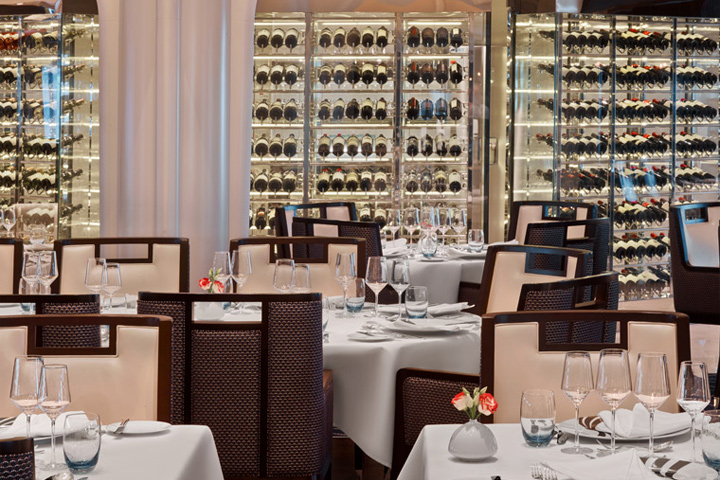
The Restaurant
Main Dining
The Restaurant: Come when you like, with whom you please, and be seated as you wish. The room is beautiful, the cuisine is exquisite, and the service is simultaneously flawless, friendly and fun.
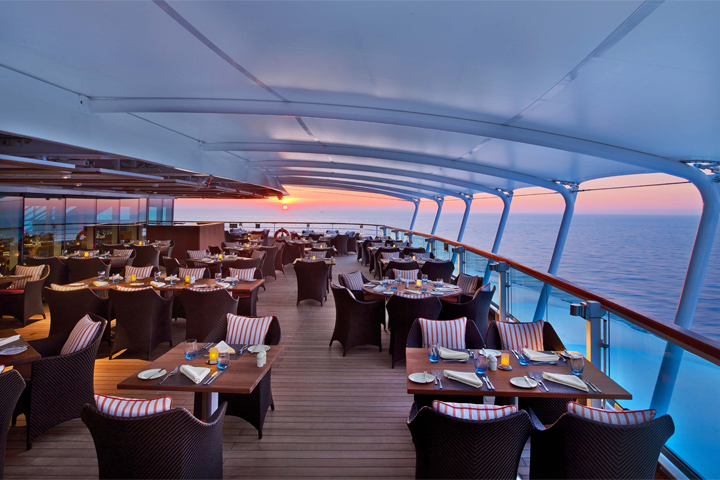
The Colonnade
Casual Dining
Coffee Bar: Enjoy a specialty crafted espresso just the way you like it.
Earth & Ocean: Each evening, the skilled chefs create an imaginative array of fresh, inventive dishes—a sophisticated menu celebrating eclectic traditional flavors from around the world, served in a relaxed setting under the stars for a distinctive dining experience unlike any other on board.
Observation Bar: A stunning round lounge with a square bar and panoramic views. Early Risers’ Coffee and Tea is served here every morning, and piano music makes it a great choice for drinks and conversation before and after dinner.
Seabourn Square: Whether you're looking for a place to enjoy your newspaper in the morning or want to socialize with your fellow passengers, Seabourn Square is what you're looking for. This inviting lounge offers plush seating, cocktail tables, a library, computer terminals, a coffee bar, and Guest Services staff.
Solis: Offering light, modern Mediterranean cuisine bursting with color and character, prepared fresh and entirely from scratch.
The Club: Open for afternoon tea then transforms into a dance club in the evening. Socialize while enjoying cocktails, live music, and great company.
The Colonnade: The more casual, indoor/outdoor alternative features an open kitchen, lavish buffets or table service for breakfasts and lunch, and serves regionally themed, bistro-style dinners with table service nightly.
The Patio: Relaxed poolside dining offering luncheon buffets, salads, soups, grilled specialties and freshly baked pizza. Dinners feature a full menu in an alfresco setting.
Sky Bar: A place to enjoy a refreshing tropical beverage during the day, or an evening cocktail under the stars.
Sushi: Seabourn researched ingredients and developed a menu that is an ideal blend of authenticity to maintain the root of the cuisine and a twist of Seabourn’s culinary expertise. The sushi concept is a modern line that is steeped in tradition and uses some of the finest ingredients. Hamachi, tuna, shrimp and other fresh fish products will be shipped from Japan to Sushi and served à la carte for dinner. The menu features caviar and small plates, along with a selection of maki rolls, sushi and sashimi, and salads.
In-Suite Dining: A varied menu available around the clock for service in your suite. You may also order dinner from The Restaurant menu and have your meal served, course by course, in your suite or on your veranda.
All Veranda Suites feature a full-length window and glass door to private veranda, comfortable living area, queen-size bed or two twin beds, dining table for two, walk-in closet, interactive flat-screen television with music and movies, fully stocked bar and refrigerator, makeup vanity, spacious bathroom with separate tub and shower.
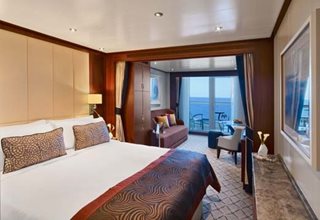
Category: V4
All Veranda Suites feature a full-length window and glass door to private veranda, comfortable living area, queen-size bed or two twin beds, dining table for two, walk-in closet, interactive flat-screen television with music and movies, fully stocked bar and refrigerator, makeup vanity, spacious bathroom with separate tub and shower.

Category: V3
All Veranda Suites feature a full-length window and glass door to private veranda, comfortable living area, queen-size bed or two twin beds, dining table for two, walk-in closet, interactive flat-screen television with music and movies, fully stocked bar and refrigerator, makeup vanity, spacious bathroom with separate tub and shower.

Category: V2
All Veranda Suites feature a full-length window and glass door to private veranda, comfortable living area, queen-size bed or two twin beds, dining table for two, walk-in closet, interactive flat-screen television with music and movies, fully stocked bar and refrigerator, makeup vanity, spacious bathroom with separate tub and shower.

Category: V1
All Veranda Suites feature a full-length window and glass door to private veranda, comfortable living area, queen-size bed or two twin beds, dining table for two, walk-in closet, interactive flat-screen television with music and movies, fully stocked bar and refrigerator, makeup vanity, spacious bathroom with separate tub and shower.

Category: SV
This category can be booked for a special rate, guaranteed to you. Please note that the category is not associated at the time of booking with a specific stateroom, deck, bedding configuration or other particular settings. The assignment of an actual cabin will be performed during your check-in. The cabin can be anywhere on the ship.

Category: RB
This category can be booked for a special rate, guaranteed to you. Please note that the category is not associated at the time of booking with a specific stateroom, deck, bedding configuration or other particular settings. The assignment of an actual cabin will be performed during your check-in. The cabin can be anywhere on the ship.

Category: OB
This category can be booked for a special rate, guaranteed to you. Please note that the category is not associated at the time of booking with a specific stateroom, deck, bedding configuration or other particular settings. The assignment of an actual cabin will be performed during your check-in. The cabin can be anywhere on the ship.
All Penthouse Suites on board feature a comfortable living area, glass door to private veranda, queen-size bed or two twin beds; walk-in closet with personal safe, two flat-screen TV with music and movies, fully stocked bar and refrigerator, writing desk with personalized stationary, makeup vanity, spacious bathroom with separate tub and shower, plush robes, slippers hair dryer and 110/220V AC outlets.
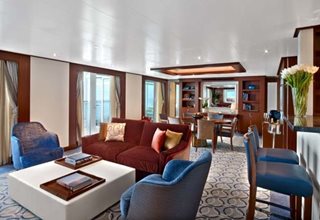
Category: GR
Suites on board feature a comfortable living area, private veranda, queen-size-bed or two twin beds; walk-in closet with personal safe, interactive flat-screen TV with music and movies, fully stocked bar and refrigerator, writing desk with personalized stationary, makeup vanity, spacious bathroom with separate tub and shower, plush robes, slippers, hair dryer, and 110/220V AC outlets.

Category: WG
Suites on board feature a comfortable living area, private veranda, queen-size-bed or two twin beds; walk-in closet with personal safe, interactive flat-screen TV with music and movies, fully stocked bar and refrigerator, writing desk with personalized stationary, makeup vanity, spacious bathroom with separate tub and shower, plush robes, slippers, hair dryer, and 110/220V AC outlets.
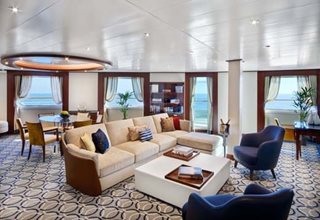
Category: SS
Suites on board feature a comfortable living area, private veranda, queen-size-bed or two twin beds; walk-in closet with personal safe, interactive flat-screen TV with music and movies, fully stocked bar and refrigerator, writing desk with personalized stationary, makeup vanity, spacious bathroom with separate tub and shower, plush robes, slippers, hair dryer, and 110/220V AC outlets.
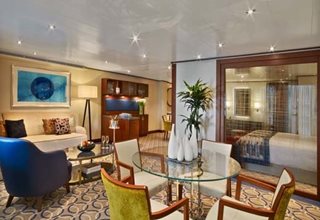
Category: O2
Suites on board feature a comfortable living area, private veranda, queen-size-bed or two twin beds; walk-in closet with personal safe, interactive flat-screen TV with music and movies, fully stocked bar and refrigerator, writing desk with personalized stationary, makeup vanity, spacious bathroom with separate tub and shower, plush robes, slippers, hair dryer, and 110/220V AC outlets.

Category: O1
Suites on board feature a comfortable living area, private veranda, queen-size-bed or two twin beds; walk-in closet with personal safe, interactive flat-screen TV with music and movies, fully stocked bar and refrigerator, writing desk with personalized stationary, makeup vanity, spacious bathroom with separate tub and shower, plush robes, slippers, hair dryer, and 110/220V AC outlets.
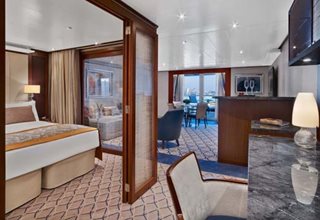
Category: PS
All Penthouse Suites on board feature a comfortable living area, glass door to private veranda, queen-size-bed or two twin beds; walk-in closet with personal safe, two flat-screen TV with music and movies, fully stocked bar and refrigerator, writing desk with personalized stationary, makeup vanity, spacious bathroom with separate tub and shower, plush robes, slippers, hair dryer, and 110/220V AC outlets.
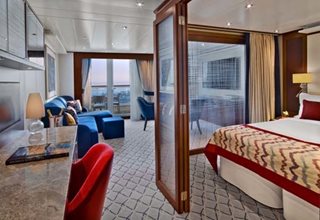
Category: PH
All Penthouse Suites on board feature a comfortable living area, glass door to private veranda, queen-size-bed or two twin beds; walk-in closet with personal safe, two flat-screen TV with music and movies, fully stocked bar and refrigerator, writing desk with personalized stationary, makeup vanity, spacious bathroom with separate tub and shower, plush robes, slippers, hair dryer, and 110/220V AC outlets.

Category: PG
This category can be booked for a special rate, guaranteed to you. Please note that the category is not associated at the time of booking with a specific stateroom, deck, bedding configuration or other particular settings. The assignment of an actual cabin will be performed during your check-in. The cabin can be anywhere on the ship.
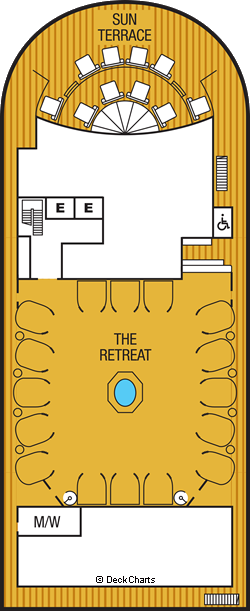
| Symbol | Description |
|---|---|
 | Subject to noise when anchoring; has all-metal veranda railings, limiting the view |
 | Wheelchair accessible suite, roll-in shower only, wheelchair-accessible doorways |
 | Elevator |
 | The veranda railings on Deck 5 are part metal and part glass from floor to teak rail; suites on Deck 5 have slightly larger verandas |
 | Third guest capacity suite |
 | Shower only |
 | Obstructed port side view with larger veranda overlooking the center pool |
 | Veranda railings are part metal and part glass; the forward half of the railing is metal and aft half is glass with teak rail |
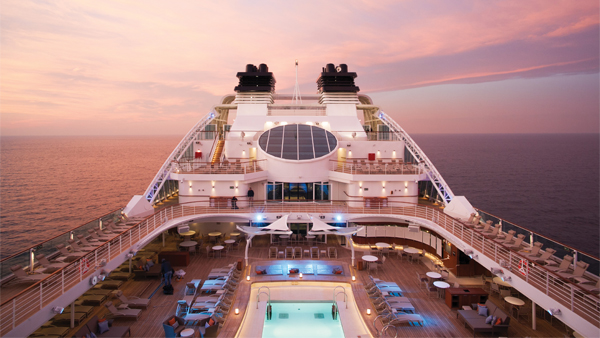
- Ship Name: Seabourn Encore
- Year Built: 2016
- Year Entered Present Fleet: 2016
- Ship Class: E
- Maximum Capacity: 600
- Number of Passenger Decks: 10
- Number of Crew: 395
- Officers' Nationality: International
- Ocean-View with Balcony: 262
- Tonnage (GRT): 43,000
- Capacity Based on Double Occupancy: 600
- Country of Registry: The Bahamas
- Total Staterooms: 300
- Suites with Balcony: 38
- Crew/Hotel Staff Nationality: International
Available Dates & Prices
Terms & Conditions
*Price shown is per person based on double occupancy, is valid for select stateroom categories only, and does include government taxes/fees and gratuities. Click on the Terms & Conditions link below for details.
**Select complimentary shore excursions are for full-fare guests only, capacity controlled and subject to availability. Shore excursion reservations are accepted on a first-come, first-served basis. Please note, available excursions vary by sailing date and day of the week. Government fees and taxes are included. Requested excursions may not be available at time of booking. Supplement will apply on Ventures by Seabourn®, optional shore excursions. Restrictions apply and penalties apply 36 hours prior to shore excursion start date.
†One Digital Costco Shop Card per room/stateroom, per stay. The exact amount of the Digital Costco Shop Card will be calculated during the booking process. The Digital Costco Shop Card promotion is nontransferable and may not be combined with any other promotion. A Digital Costco Shop Card will arrive by email approximately 10 days after the start of your cruise. Click on the Terms & Conditions link below for additional information.
Ship's registry: The Bahamas
Digital Costco Shop Card
Book this vacation or cruise with Costco Travel and receive a Digital Costco Shop Card. The Digital Costco Shop Card is a convenient payment option in our warehouses and on Costco.ca.



















